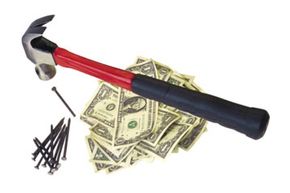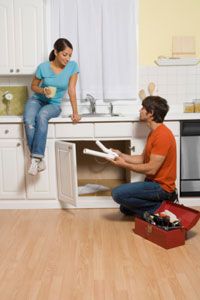
If you're planning to sell your home, chances are you've already done the math and decided it's the right time. You may have even done enough research to sell your house confidently without an agent. Congratulations! But what's the next step?
While thinking in terms of the sale probably has you looking at your home in a new way, it can also magnify your perception of problems you've learned to deal with. You would think that major improvements, like new siding or a kitchen renovation, would help you boost your sale price. But the truth is, most major renovation projects don't make back their investments quickly, if at all: The cost nearly always outweighs the immediate benefit. It might be better to work with what you have.
Advertisem*nt
Or, think of it this way: Part of the fun of acquiring a new home is changing it to suit your family's needs. Let the buyers shoulder these major renovation costs -- and create what they really want -- rather than you paying to remake something they might not like anyway.
If you've decided to sell, it's not your home anymore. It's a product, and that means selling it at its best while saving your money for the really exciting part: renovating your new home and making it the perfect location for the next chapter in your life.
There are plenty of low-cost options for transforming your home from a fixer-upper into a showstopper: not only alternatives to expensive renovations that will increase your home's value, but also hints and tricks the professionals use to help prospective buyers see the real comfort and joy in the house you're handing over to them.
Advertisem*nt
Contents
- Reinvention, Not Renovation
- Other Costs & Strategies
- Cost/Benefit Statistics
Reinvention, Not Renovation
Rather than spending your money on improvements for your house's next owners to enjoy, focus on showing your home in its best light. Let's look at some common renovations and their immediate benefits, as well as other ways to make the most of your sale.
For example, an outdoor deck not only creates a good place to entertain, but can also improve your backyard's look and make it more inviting. It's one of the most cost-effective renovation projects you can do (average cost $10,601, recoup value $8,676), but you'll still only see about an 82 percent return. And since you won't be there to enjoy it, you're spending around $1,925 on another family's enjoyment [source: Remodeling Magazine].
Advertisem*nt
By staging the backyard in an inventive and practical way, you can save money and add to value at the same time. How about laying down fresh sod and grass seed? By installing a small birdfeeder, you can create a point of visual interest. Inexpensive bistro furniture can create that outdoor-living feel at a fraction of the price, and you can take those props with you to your next home!
An average bathroom remodel cost $15,899 in 2010, with a recoup value of $11,857. That's only a 74.6 percent return on your investment in a bathroom you'll never get to use [source: Remodeling Magazine]. Instead, increase your sale value by styling the bathroom in a way that's inviting, luxurious and simple. Updated drawer pulls and fixtures, and tiny touches like fresh soaps and freshly folded towels can help a sparkling-clean bathroom appeal to buyers every bit as much as a newly installed toilet.
If you're thinking of renovating a spare bedroom, turn it into a guest room. All you need is a bed frame, an inflatable mattress and some luxurious bedding. Turning that room into another comforting environment will make the whole house seem bigger!
Advertisem*nt
Other Costs & Strategies

Put yourself in your buyer's shoes to make sure you have everything covered. A home inspection before you put out the for-sale sign will run you $200 to $300 but could save you a lot if your buyers discover something before you do -- and you can bet their inspector will find it. Heating, air conditioning, water, electricity, plumbing and gas should all be in good condition before you think of putting your house on the market. Don't forget to check for mold in the basem*nt or signs of termite damage.
If you have any home projects you've been meaning to finish, now is the time. The National Association of Realtors suggests that buyers will automatically subtract double the cost of any unfinished projects when they make an offer. Think of these unfinished issues as repair problems with the house, and deal with them accordingly.
Advertisem*nt
Whatever improvements you do make, double-check that they're in line with your neighborhood. Research shows that projects and renovations made too much higher or lower than the neighborhood average won't make back their investments, and they could scare off potential buyers who expected something different from the area. Visit other open houses nearby to get a feel for what's normal in your area.
Remember that you want your buyers to imagine themselves in the house. You want it to be both comfortable enough to seem like home, and just generic enough that it doesn't feel like somebody else's personal space. While high-tech kitchen or bath amenities are a nice touch, they don't make the decision for your buyers: The overall look and feel is what makes your property memorable as a place for buyers to start a new home.
Advertisem*nt
Cost/Benefit Statistics
The first and most important rule of thumb when it comes to updating your home before a sale: Only invest in improvements -- whether renovation, upkeep or home staging -- that will add at least twice their cost to your home's value. As we saw above, that limits or rules out major projects. So what's left? The magic of home staging, which presents your home's bare bones in the best possible way, can have unbelievable effects on your house's sale speed and final price.
Home staging can improve your sale price by an average of six percent, and you could sell up to 50 percent faster [source: Home Staging Resource]. The less time a house is on the market, the better the sale will be -- and the less time you'll be in limbo. By spending the time and money now to make sure your house is the most attractive it can be, you'll reap benefits in both the short and long term.
Advertisem*nt
But how much should you spend? Well, there's no limit to the amount of elbow grease you can put in while your home's on the market. And you will put in a lot! But as far as finances, plan to budget one to three percent of your asking price for staging [source: Tracey]. That includes props, rentals and services (power washers, lawn care, deep cleaning), and possibly engaging a professional stager.
Staging services themselves average $400 to $600 nationally, depending on the market and your square footage. Add this negligible expense to the money you'll make: According to a 2007 survey, homes that spent $5,000 to $8,000 on staging and home improvements averaged a 150 percent return on that investment [source: Gopalakrishnan].
Every home, market and buyer is different, and buyers are looking for the best possible house for their needs. But by using staging techniques and being clever with your improvements budget, you can keep your asking price high and save money that would otherwise have gone toward renovations. That's money in your pocket that you can use to make your next home even more perfect for you and your family.
Advertisem*nt
Lots More Information
Related Articles
- How Selling a House Works
- How Home Sales By Owner Works
- Cha-ching: Test Your Home Selling Smarts Quiz
- How Realtors Work
- Home Improvement
Sources
- Barr, Dave. "How Much Should I Spend Getting My House Ready To Sell?" DaveBarrHomes.com. Jan. 1, 2009. (Jan. 3, 2011)http://davebarrhomes.com/dave-barr/2009/01/how-much-should-i-spend-getting-my-house-ready-to-sell
- Gopalakrishnan, Jessica. "On the Home Seller's Radar, Part 1: Kitchen and Bathrooms." HomeGain.com. Dec. 21, 2007. (Jan. 3, 2011)http://blog.homegain.com/home-improvement/on-the-home-sellers-radar-kitchen-and-bathrooms/
- Gopalakrishnan, Jessica. "On the Home Seller's Radar, Part 2: Home Staging." HomeGain.com. Dec. 26, 2007. (Jan. 3, 2011)http://blog.homegain.com/home-improvement/on-the-home-sellers-radar-home-staging/
- Home Staging Resource. "Is Your Home 'Sale' Ready." 2010. (Jan. 3, 2011)http://www.homestagingresource.com/homesellers.asp
- Lynn, Kathleen. "A fix-up strategy works in long run." The Record. Oct. 11, 2009. (Jan. 3, 2011)http://www.northjersey.com/realestate/63950697.html
- Remodeling Magazine. "Remodeling Cost vs. Value Report 2010-11." November 2010. (Jan. 3, 2011)http://www.costvsvalue.com
- Roberts, Gretchen. "7 Tips to Fix Up a Foreclosure (Without Breaking Your Budget)." HGTV's FrontDoor.com. June 22, 2009. (Jan. 3, 2011)http://www.frontdoor.com/Buy/7-Tips-To-Fix-Up-A-Foreclosure-without-Breaking-Your-Budget/55150
- Tracey, Melissa Dittmann. "Staging Strategies for What Buyers Want." Realtor Magazine. May 12, 2010. (Jan. 3, 2011)http://styledstagedsold.blogs.realtor.org/2010/05/12/staging-strategies-for-what-buyers-want/#more-1428
As an experienced real estate professional and home improvement enthusiast, my extensive background in the field equips me to provide valuable insights into the intricacies of selling a home and maximizing its value. Over the years, I have been deeply involved in various aspects of real estate, from understanding market trends to implementing effective strategies for enhancing property appeal.
Now, delving into the concepts presented in the article, it emphasizes the shift from considering your home as a personal space to treating it as a product when preparing to sell. This transition is crucial, as it sets the stage for adopting a strategic approach to increase the property's market value while minimizing unnecessary expenses.
The article advocates for a focus on "reinvention, not renovation," highlighting that major renovation projects may not yield significant returns on investment. Instead, the emphasis is on showcasing the existing features of the home in the best possible light. This includes cost-effective alternatives to traditional renovations, such as creative backyard staging and bathroom styling.
One key concept is the idea that certain renovations, like adding an outdoor deck or remodeling a bathroom, may not provide a high return on investment. The article suggests that sellers should consider low-cost options and strategic improvements, such as transforming a spare bedroom into a guest room, to enhance the overall appeal of the property.
The importance of considering other costs and strategies is underscored, with a specific mention of the significance of a pre-sale home inspection. Addressing potential issues beforehand can prevent surprises during the selling process and potentially save money in the long run. Unfinished projects are also highlighted as potential deterrents for buyers, who might subtract double the cost of incomplete tasks when making an offer.
Furthermore, the article advises sellers to align any improvements with the neighborhood average, emphasizing that projects significantly deviating from the norm might not yield positive returns and could deter potential buyers.
A significant portion of the article is dedicated to the concept of home staging as a powerful tool for increasing a property's sale price and reducing its time on the market. The cost-benefit statistics provided stress the importance of investing in improvements that add at least twice their cost to the home's value. The article suggests budgeting one to three percent of the asking price for staging, including props, rentals, and services.
In conclusion, the article provides a comprehensive guide for sellers, combining practical advice with cost-effective strategies to optimize a home's appeal in the competitive real estate market. This aligns with my expertise, as I have witnessed firsthand the impact of these concepts on successful home sales and satisfied clients.